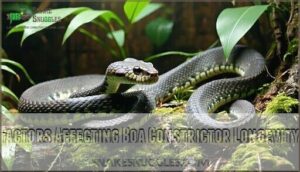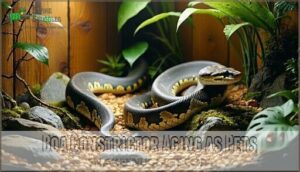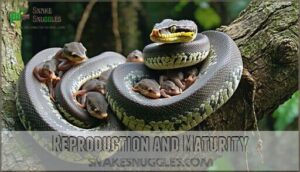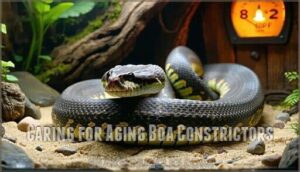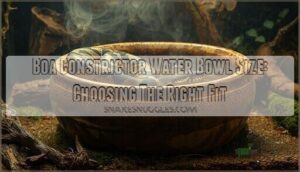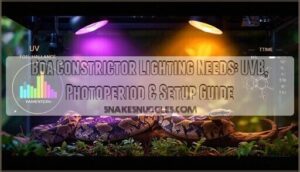This site is supported by our readers. We may earn a commission, at no cost to you, if you purchase through links.
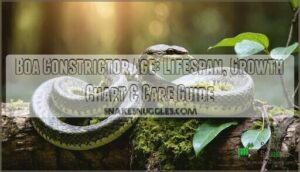
In the wild, these powerful serpents typically live 15-20 years, facing predators and environmental challenges. However, captive boas can reach 25-30 years with proper care.
Your boa’s lifespan depends on several key factors: genetics, diet quality, habitat conditions, and veterinary care.
Young boas grow rapidly, reaching sexual maturity around 3-4 years old. As they age, their growth slows considerably.
The oldest recorded boa constrictor lived over 40 years in captivity. Understanding your snake’s aging process helps you provide better care and recognize when special attention becomes necessary.
Table Of Contents
- Key Takeaways
- Boa Constrictor Lifespan
- Wild Vs. Captive Boa Constrictor Lifespan
- Factors Affecting Boa Constrictor Longevity
- Record for Oldest Boa Constrictor
- Boa Constrictor Aging as Pets
- Boa Constrictor Aging in The Wild
- Boa Constrictor Life Cycle
- Caring for Aging Boa Constrictors
- Frequently Asked Questions (FAQs)
- How do you tell the age of a boa?
- How much should a 7 foot boa weigh?
- How old do boa constrictors live?
- What is the max age for a boa?
- How old is the oldest boa constrictor?
- How long do boa constrictors live as pets?
- How can genetic testing determine a boas age?
- What are the signs of aging in boas?
- At what age do boas typically mature?
- Do boa constrictors diet affect aging?
- Conclusion
Key Takeaways
- You can expect your boa constrictor to live 20-30 years in captivity, potentially reaching 40+ years with exceptional care, compared to just 15-20 years in the wild due to predators and environmental challenges.
- Your boa’s lifespan depends on factors you control: genetics from reputable breeders, proper habitat conditions (75-95°F temperature gradient, 50-60% humidity), quality diet with appropriate feeding schedules, and regular veterinary care.
- You’ll notice your boa reaches sexual maturity at 2-4 years old, with females maturing later but growing larger than males, and both sexes continuing to grow slowly throughout their entire lives.
- As your boa ages, you’ll need to adjust care by providing easier access to basking spots, smaller meals, softer substrates, and increased veterinary monitoring to catch age-related health issues early.
Boa Constrictor Lifespan
The boa constrictor lifespan stretches impressively long, making these reptiles true long-term companions. Your boa’s average life expectancy ranges from 20-30 years in captivity, with exceptional specimens reaching the maximum boa age of over 40 years.
These remarkable serpents offer decades of companionship, with proper care extending their impressive lifespan well beyond most pets.
Boa constrictor longevity depends on several key factors. These non-venomous constrictors grow continuously throughout their boa constrictor years, reaching lengths over 10 feet. Their calm temperament and adaptability contribute to their impressive average boa lifespan.
Understanding boa lifespan stages helps you prepare for decades of care. Young boas grow rapidly, while adults focus on maintaining health. Boa longevity factors include proper nutrition, habitat conditions, and veterinary care.
Wild boas, however, face challenges, often resulting in a shorter lifespan compared to their captive counterparts, with typical lifespans around 20 years. The boa health impact on lifespan can’t be understated. With consistent care, your boa constrictor age can extend well into their third decade, offering you years of fascinating interaction with these remarkable serpents.
Wild Vs. Captive Boa Constrictor Lifespan
Understanding the difference between wild and captive boa constrictor lifespans reveals fascinating insights about these remarkable reptiles.
In their natural habitat, boas typically live 20-25 years, though some reach 30 years.
Wild longevity faces constant challenges from predators, disease, and habitat destruction.
Natural threats like jaguars, birds of prey, and human encroachment substantially impact their survival rates.
Captive advantages become obvious when you compare these numbers.
Pet boas routinely exceed 30 years, with many reaching 40+ years.
The oldest recorded captive boa lived an impressive 42 years and 6 days.
This dramatic difference stems from controlled environments, regular veterinary care, and consistent captive diet schedules.
It’s worth noting that the oldest snake ever recorded, a Columbian rainbow boa named Ben, lived to be this age in captivity.
| Environment | Average Lifespan | Maximum Recorded | Primary Challenges | Key Advantages |
|---|---|---|---|---|
| Wild | 20-25 years | 30 years | Predators, disease | Natural behavior |
| Captive | 30+ years | 42+ years | Owner knowledge | Controlled care |
Environment impact plays a vital role in determining these lifespan factors, making proper husbandry essential for maximizing your boa’s longevity.
Factors Affecting Boa Constrictor Longevity
Your boa constrictor’s lifespan depends on several key factors you can directly control through proper care.
The quality of their habitat, diet, and genetics all play vital roles in determining whether your snake reaches 20 years or potentially 40 years of age.
Habitat and Environment
Different environments shape how long your boa constrictor lives. Wild boas face predators, diseases, and food shortages that captive snakes don’t encounter. Your pet’s boa constrictor habitat directly impacts its health and longevity through proper environmental conditions.
Temperature gradients between 75-95°F let your snake regulate its body heat effectively. Humidity levels around 50-60% support healthy shedding and respiratory function. Enclosure size matters too – cramped spaces stress your boa and shorten its lifespan.
Boa constrictors are sometimes kept as pets for rodent infestation control in some regions.
Consider these environmental factors for ideal health:
- Lighting needs that mimic natural day/night cycles
- Substrate choice that maintains proper moisture without harboring bacteria
Getting these boa constrictor environmental factors right means your snake can live its full 20-30 year potential in captivity.
Genetics and Health
Beyond proper habitat conditions, your boa’s genetic predisposition plays a vital role in determining lifespan.
Some bloodlines carry inherited diseases like neurological disorders or immune deficiencies that can substantially shorten life expectancy. Breeding impact from related parents often produces mutation effects including "spider wobble" or other neurological issues.
Regular health monitoring through reptile veterinary checkups helps catch problems early.
Strong boa constrictor genetics from reputable breeders typically result in healthier, longer-lived snakes with fewer hereditary complications.
Diet and Nutrition
Proper nutrition forms the foundation of your boa constrictor’s longevity.
Feeding frequency depends on age—juveniles need meals every 5-7 days, while adults require food every 10-14 days.
Prey size should match your snake’s thickest body section to prevent digestive issues.
Focus on food quality by offering pre-killed rodents like mice and rats.
Maintain consistent meal frequency to meet their nutritional needs while preventing obesity.
Your boa constrictor diet doesn’t typically require supplementation if you provide varied, appropriately-sized prey.
Consider specialty food products for variety.
Nutrition directly impacts growth rate, immune function, and overall lifespan—making dietary management essential for your snake’s health.
Record for Oldest Boa Constrictor
The oldest recorded boa constrictor achieved an astounding 42 years and 6 days, with Ben being the most documented case before his death in 2016.
Ben’s incredible 42-year journey proves that with exceptional care, boa constrictors can truly become lifelong companions.
These exceptional cases showcase how captivity advantages like controlled environments and veterinary care extend boa constrictor life span beyond typical 20-30 year expectations.
Historical records reveal genetic anomalies and ideal longevity factors can push boa constrictor age limits.
Such achievements in age determination demonstrate these serpents’ remarkable potential when given proper care and conditions.
Boa Constrictor Aging as Pets
Senior-citizen snakes require special attention as they enter into their golden years.
Your aging boa will show subtle behavioral changes and slower movements.
Pet Boa Care becomes more delicate—handle gently since older boas develop joint stiffness.
Aging Signs include reduced appetite and less activity.
Veterinary Needs increase substantially; schedule regular check-ups to catch health issues early.
Enclosure Adjustments help maintain comfort—add softer substrates and easier climbing options.
When quality of life deteriorates, End-of-Life decisions become necessary considerations for responsible ownership.
Boa Constrictor Aging in The Wild
In contrast to their pampered captive cousins, wild boa constrictors face a rougher reality in terms of longevity.
You’ll find that wild boas typically live 20-25 years, substantially shorter than their captive counterparts.
The harsh wilderness doesn’t offer the luxury of controlled environments and guaranteed meals.
Wild Lifespan Factors create a challenging survival game:
- Natural Predators like jaguars, caimans, and birds of prey constantly threaten younger boas
- Habitat Impact from deforestation and human encroachment reduces territory and prey availability
- Wild Diet inconsistency means periods of feast or famine affect growth and health
- Disease Prevalence spreads unchecked without veterinary intervention
- Environmental extremes including droughts, floods, and temperature fluctuations stress their systems
Age determination becomes nearly impossible in wild populations, making precise boa constrictor age studies difficult.
However, researchers estimate the boa age range rarely exceeds 25 years in natural settings.
Boa Constrictor Life Cycle
You’ll notice your boa constrictor experiences distinct life stages from a 20-inch hatchling to a mature 6-10 foot adult over several years.
Understanding this growth cycle helps you provide proper care as your snake develops from rapid juvenile growth to slower adult maintenance phases, which is crucial for the overall health and well-being of your snake.
Reproduction and Maturity
In the context of boa constrictor breeding, sexual maturity marks a pivotal milestone.
Females reach breeding age around 3-4 years, while males mature at 2-3 years.
The gestation period spans 5-8 months, with mothers carrying developing embryos internally.
Litter size typically ranges from 10-50 babies, depending on the female’s size.
During the birthing process, newborns emerge fully independent, ready to hunt and survive without parental care from day one.
Growth and Development
After boas reach maturity, they continue growing throughout their lives, though at dramatically different rates.
Your boa constrictor’s growth follows predictable patterns from birth to adulthood, with females outpacing males in both size and growth rate.
You’ll need to keep in mind the enclosure product options as they grow.
- Hatchling Development: Newborns start at 18-24 inches, weighing just 0.25-0.5 pounds
- Juvenile Growth: Rapid expansion during first 6 years, reaching 2-3 feet with weekly feeding
- Subadult Changes: Growth slows at 2-3 years, females reaching 5-7 feet, males 4-6 feet
- Adult Size: Most reach 6-8 feet by age 5-6, with continued slow growth
Caring for Aging Boa Constrictors
Your aging boa needs geriatric boa care adjustments as it reaches its golden years.
Enclosure adjustments become essential – provide easier access to basking spots and maintain 80-85°F temperatures since older snakes handle temperature changes poorly.
A senior diet with smaller, less frequent meals helps prevent digestive issues.
Maintaining proper humidity is also important to help with shedding.
Watch for aches and pains like slower movement or reluctance to climb.
Regular veterinary care catches end-of-life complications early.
With proper care and ideal environmental conditions, you’ll maximize your boa’s lifespan and health during its twilight years.
Frequently Asked Questions (FAQs)
How do you tell the age of a boa?
Like solving a puzzle without all the pieces, determining your boa’s age requires detective work.
Contact the breeder first, then examine size, coloration brightness, and shedding frequency.
Younger boas display vibrant colors and shed more often.
How much should a 7 foot boa weigh?
A healthy 7-foot boa should weigh between 15-25 pounds, with females typically heavier than males.
You’ll want to monitor body condition rather than just weight, as genetics and build affect ideal weight ranges substantially, considering complete concepts is crucial.
How old do boa constrictors live?
Time unfolds like a serpent’s coil for your boa constrictor.
You’ll enjoy decades together – they typically live 20-30 years in captivity, with exceptional specimens reaching 40+ years through proper care, diet, and veterinary attention.
This allows for a long and rewarding relationship with your pet, emphasizing the importance of proper care.
What is the max age for a boa?
You can expect your boa constrictor to reach a maximum age of around 40 years in captivity with excellent care. The longest recorded lifespan was 40 years, 4 months.
How old is the oldest boa constrictor?
The oldest recorded boa constrictor lived an impressive 40 years, 3 months, and 14 days in captivity.
You’ll find captive boas typically outlive their wild counterparts due to controlled environments, proper veterinary care, and consistent nutrition.
How long do boa constrictors live as pets?
Your pet boa can live 20-30 years with proper care, sometimes reaching 40+ years. Captive boas typically outlive wild ones due to consistent diet, controlled environment, and veterinary care when needed.
How can genetic testing determine a boas age?
Genetic markers in DNA show age-related changes, but you’re looking at early-stage research that’s not widely available yet.
Currently, genetic testing can’t precisely determine your boa’s age like it does for other species.
What are the signs of aging in boas?
Your boa’s coloration will fade from bright juvenile hues to duller adult tones.
You’ll notice slower growth rates, less frequent shedding, calmer temperament, and possible minor scarring or regrown scales indicating maturity.
At what age do boas typically mature?
Like flowers blooming in spring, sexual maturity unfolds differently for male and female boas.
Males typically reach reproductive readiness at 2 years old, while females mature later at 3-4 years when they’ve gained sufficient size.
Do boa constrictors diet affect aging?
Diet directly impacts your boa’s aging process and lifespan.
Proper nutrition, appropriate feeding schedules, and quality prey extend their life substantially.
Poor diet choices, overfeeding, or inadequate nutrition accelerate aging and reduce longevity.
Conclusion
Understanding boa constrictor age transforms you from a casual owner into a dedicated caretaker.
While wild boas face constant survival challenges, your captive snake can thrive for decades with proper attention.
You’ll witness remarkable growth patterns, from rapid juvenile development to steady adult maturity.
Quality nutrition, ideal habitat conditions, and regular veterinary checkups directly impact longevity.
By recognizing aging signs and adapting care accordingly, you’re ensuring your boa lives its fullest possible lifespan in your dedicated hands.
- https://seaworld.org/animals/facts/reptiles/boa-constrictor
- https://www.nationalgeographic.com/animals/reptiles/facts/boa-constrictor
- https://www.woburnsafari.co.uk/discover-your-safari/meet-the-animals/boa-constrictor
- https://www.petmd.com/reptile/boa-constrictor-care-sheet
- https://www.riverviewparkandzoo.ca/en/zoo/boa-constrictor.aspx

